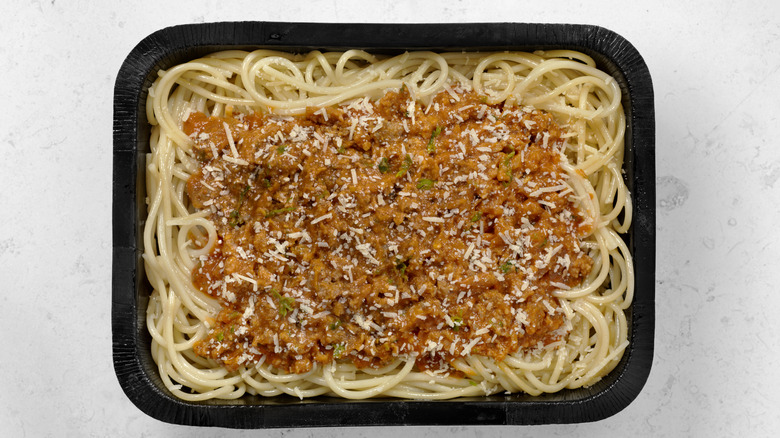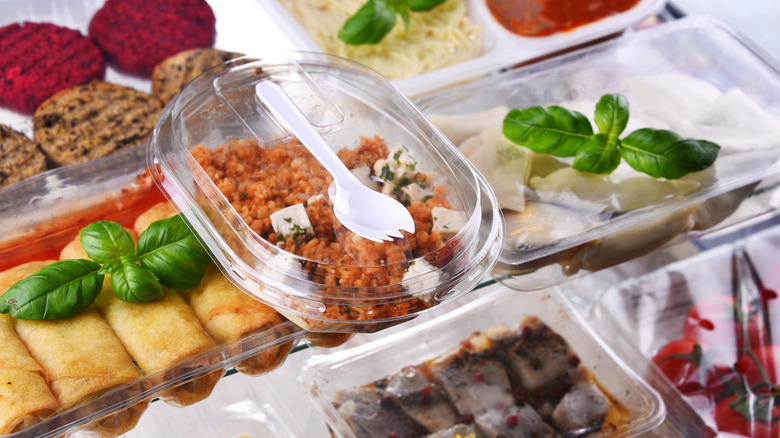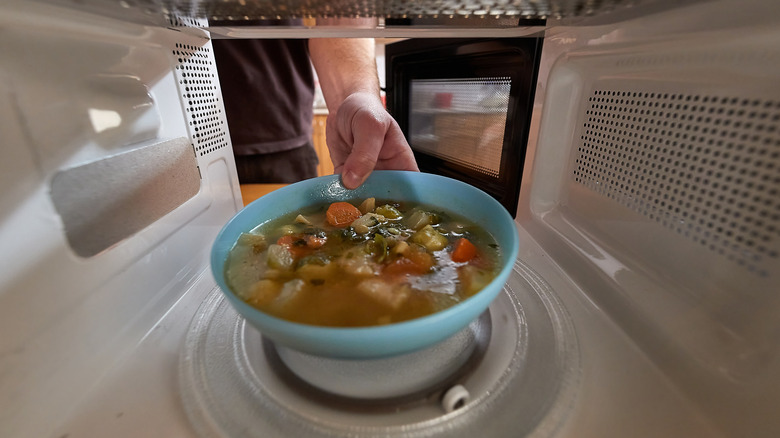Why You Should Never Buy Reheatable Pasta At The Grocery Store
Whether you forgot to bring lunch to the office or are trying to find a quick way to dinner, we can all appreciate the convenience of eating out. While it can be pricey to go to restaurants too often, there are many specialty markets and grocery stores that have reasonably priced pre-made meals to quickly heat up at home, offering the same time-saving benefits. But, it's good to know that there are dishes that don't reheat well, and pasta especially falls into that category.
Pasta can be finicky — just cooking it a minute too long can completely ruin the texture of the dish. Assuming the pasta was perfectly cooked al dente when it was originally prepared, reheating the starch in the microwave will only leave you with a clumpy, dry mess that feels like a doughy brick. And the thinner the pasta, the worse the reheated texture.
If the pasta is generously sauced, it won't be as sticky, but the noodles will absorb the sauce and be mushy by the time it's reheated. And while marinara reheats well, forget about it if the pasta is dressed in a cream sauce like Alfredo — you'll end up with a bowl of mushy noodles coated in a broken, oily topping.
Sadly, this warning applies to all reheated pasta dishes, including pad Thai and lo mein.
Other reheatable dishes to avoid at the grocery store
According to the United States Department of Agriculture, previously cooked foods should be reheated to an internal temperature of 165 degrees Fahrenheit in order to kill foodborne bacteria. You can use the microwave, oven, stove, or air fryer to warm up the food, but to ensure it's safe to eat, use a digital thermometer to check the temperature.
Texture is the primary concern when reheating a meal. Fatty or braised meat can be reheated without drying it out or changing the texture. But avoid expensive reheatable steaks. Unfortunately, they will dry out by the time the internal temperature reaches 165 degrees Fahrenheit.
Lean proteins like eggs, shrimp, and non-oily fish like tilapia and flounder will also become dry and rubbery if cooked again. This may mean leaving the leftover shrimp scampi at the restaurant.
Grocery store hot buffets are usually brimming with fried foods; part of the allure is their crispy texture. If you are not consuming them immediately, items like chicken wings, French fries, and egg rolls will never regain their crispiness. Most fried food is twice fried to deliver that crunchy coating, so cooking it a third time at home does nothing for the desired texture.
The best methods to reheat food
Ideally, food tastes best when it's reheated using the same method that was used to originally cook it. But, slowly reheating a dish in the oven or on the stove is usually a safe method for most dishes — just cover the pan with foil and gently heat the dish for 20 to 30 minutes. This works for reheating steaks, chicken, and heartier dishes. But, leave food like pizza or fried chicken uncovered so they can crisp up, or use the air fryer to shorten the cooking time.
The microwave is undoubtedly the fastest method, but it doesn't consistently deliver the best results. It steam cooks food, so you'll want to avoid using it to reheat anything that you want to have texture. That being said, sauces, soups, casseroles, and vegetables all do well in the microwave.
Since slow cookers and chafing dishes take hours for food to reach an internal temperature of 165 degrees Fahrenheit, they are not recommended for reheating.
Leftovers can be kept in the refrigerator for up to four days but should be discarded if the food smells or looks funny (and never leave food out of th fridge in the "danger zone" of 40 to 140 degrees Fahrenheit for more than two hours). Also, the quality of the dish will deteriorate each time it's warmed up, so reheat portions instead of the entire tray if you aren't going to finish it in one sitting.



